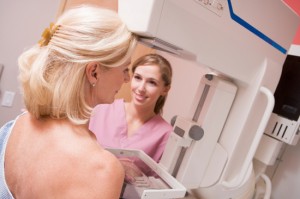There is one known breast cancer risk factor that still raises a lot of questions: breast density. Research has shown that breast cancer is up to four to five times more likely to occur in a woman with very dense breasts than one without, which is a significant difference. Unfortunately, we don’t know why this relationship between breast density and cancer exists, and we must admit we can do little to control our breast density. Still, it’s certainly worth learning a little more about breast density and how it relates to breast cancer.
What is Breast Density?
In short, a dense breast is composed of a higher ratio of breast tissue (made up of milk-producing ducts and milk-carrying lobules) and connective tissue to fatty tissue than a non-dense breast. The less fat, the denser the breast.
What Causes Breast Density?
While breast density is still being studied, it appears that a number of factors are likely at play in determining whether a woman will have dense breasts. Genetics appears to play a role, as does age, pregnancy, and childbearing. Dense breasts appear to run in families, and breast density decreases during pregnancy. Women who have given birth to several children will usually have less dense breasts.
Change in Breast Density
In addition to pregnancy, menopause also causes a major change in breast density. Hormonal changes cause the breast to become more fatty and less dense, although postmenopausal hormone therapy involving estrogen can slow this change; those same hormone treatments can also increase your risk of breast cancer.
Density in Breast on Mammograms
Breast density also affects the ability of doctors to accurately interpret mammograms. Dense breasts are more difficult to assess, because the fibrous breast tissue appears on the mammogram as white tissue, similar to any potential nodular density in the breast, such as lumps or cysts, that the mammograms are meant to detect. These irregularities can effectively “hide” amongst dense breast tissue. Breasts with a higher ratio of fat enable tumors to show up more clearly on a mammogram. While obesity is linked to breast cancer, having fatty tissue in your breasts is a good thing!
Breast Density Test
The only way to know if you have dense breasts is to undergo a mammogram or other imaging process. Your doctor will assess your breast density based on the resulting image from the mammogram. Several states (including New York and California) have even passed legislation requiring doctors to clearly inform patients if their screenings reveal higher levels of breast density.
More Effective Detection
We know that early detection is our best tool to fight breast cancer, so if you do discover that you have dense breast tissue, you’ll want to discuss options for improved breast imaging with your doctor. There are newer kinds of mammograms, like digital tomosynthesis, that might be able to capture more accurate images of the breast. Some women may add a breast ultrasound to their regular mammogram or schedule an additional clinical breast exam. In any case, knowing your own breasts and performing regular monthly breasts self-exams is one of the best ways to ensure you detect any changes.
Need help remembering to do your monthly breast self-exam or yearly mammogram? Check out our breast health appointment reminders!

